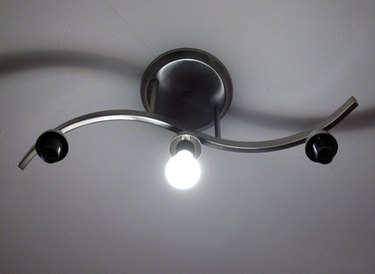Things You'll Need
Voltage tester
Pliers
3 wire caps
Screwdriver
Drill
Metal-boring drill bit
Ground screw

Wiring color codes are standardized in North America. Black wires always signify the positive, or hot, leg of the current, while white wires signify negative, also called neutral or return. Ground wires are either left bare or covered with green insulation. When there is an extra hot wire, it is red. Ceiling fixtures almost always have a black and white wire. In rare instances, the kit may include a red and yellow wire instead. In this case, red is hot. An extra red wire in the electrical box is probably an extra hot wire for a fan.
Red Wire in the Electrical Box
Step 1
Test the wires in the ceiling box with a voltage tester. If there is an extra red wire, you should get a reading of 120 volts when you touch the terminals of the tester to the red and white wires. It should be identical to the measurement when you touch the ends of the black and white wires with the voltage tester.
Video of the Day
Step 2
Turn off the power to the circuit, either by flipping a switch or turning off the breaker in the main panel that controls the circuit. Check the wires again with the voltage tester to verify that there is no voltage reading.
Step 3
Twist a wire cap onto the red wire, then push it into the box. Ensure that no metal shows outside the cap when it is fully tightened.
Step 4
Use pliers to twist the black wire from the house circuit clockwise together with the black wire of the light. When they are secure, twist on a wire cap. Repeat this process with the white wires. The light may have a bare ground wire or one covered in green insulation. Twist it together with the bare wire from the house circuit, then screw on a wire cap.
Step 5
Push the wires into the electrical box. Mount the light fixture with the included hardware.
Red Wire on the Light Fixture
Step 1
Turn off the power to the light circuit, then check the wires with a voltage tester to verify there is no voltage reading.
Step 2
Twist the red wire from the light fixture together with the black wire from the house circuit with pliers. Cap the wires.
Step 3
Twist the white wire from the house circuit together with the white or yellow wire from the light, and cap them. If there is a third wire, it will be either bare, green or blue. Twist it together with the bare wire from the house circuit. If there is no third wire, ground the fixture by attaching the bare wire to the metal base of the fixture. You may have to install a ground screw.
Step 4
Drill a hole slightly smaller than the diameter of a green ground screw in the metal base of the fixture. Screw in the ground screw. Wrap the ground wire around it, then tighten the screw.
Tip
Some low voltage lights have various colored wires, some of which are used for dimming. Consult the instructions that came with the light for the proper wire connections.
If the electrical box was previously used for a fan, the wall switch is probably a two-pole switch. Either disconnect the red wire from the switch or replace the switch with a single-pole version.
Warning
Ensure the circuit power is off before you make any electrical connections. You can receive a shock otherwise. If you are standing on a ladder at the time, the shock may cause you to fall.
Video of the Day